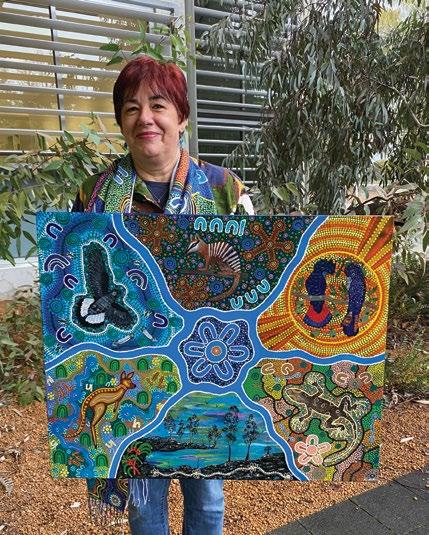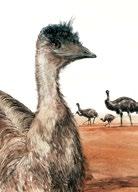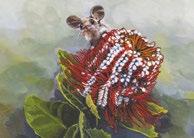

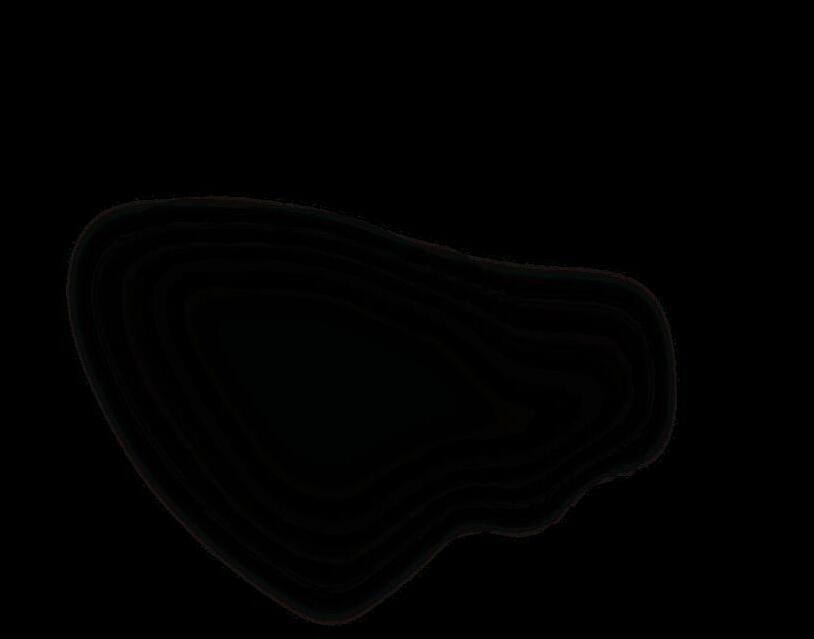
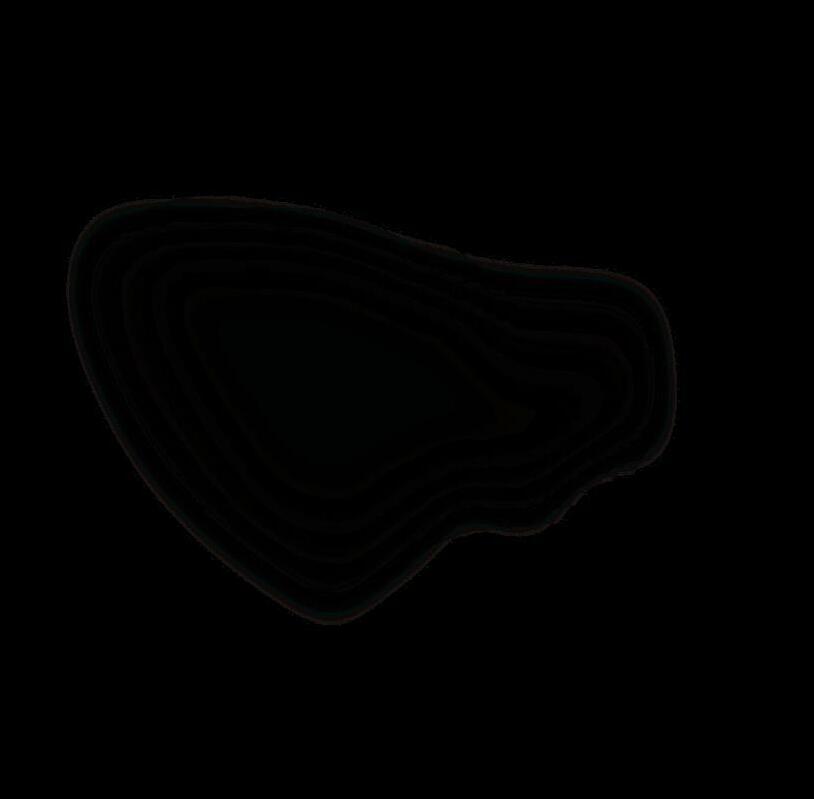


A FOOTE IN THE HAND Saving an iconic species WA’S PARKS, WILDLIFE AND CONSERVATION MAGAZINE Volume 38 Number 2 Summer 2022–23 $7.95 Wildflower wonderland Yonga Walk Trail Migration mysteries Tracking the right whales Every Kid in a Park Access for all ages
Twenty-eight
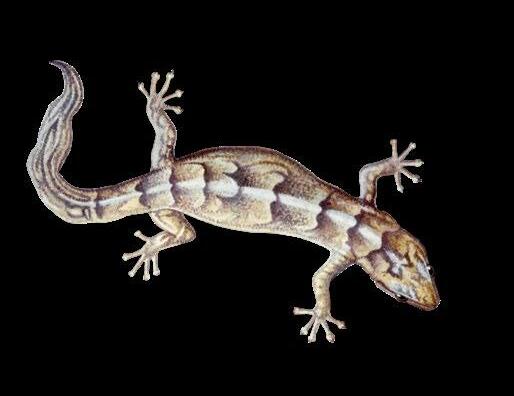


















Pink



15% DISCOUNT for LANDSCOPE subscribers LANDSCOPE subscriber price: $22.90 each *Discount code: LANDSCOPE-SUB-BB RRP $26.95 each Tuart Dwellers Meet some of the incredible creatures that live in the Tuart Forest and learn some fascinating facts about their habits and environment. Wedge grass-skippers flit from flower to flower. They lay their eggs on speargrass, which is common under tuart Adult butterflies emerge in autumn rather than spring. Spitfires (sawfly larvae) spit a bitter liquid at predators and over themselves, which makes them taste disgusting. To confuse predators, they cluster in huge repulsive clumps. Sawfly females do not mate with a male; they simply clone themselves. The female cuts into the leaf of a tuart using a saw-like device on her abdomen, and lays her eggs in the slit. She protects the eggs until they are ready to hatch; if disturbed, she buzzes her wings angrily and opens her jaws to scare away predators. Hairymary caterpillars have very hairy bodies, which deter predators. The bright red stripe acts as a warning Twisted moths look just like a dry, twisted leaf as they lie well hidden on the ground, among dead leaves The caterpillar of the twisted moth looks like a new stem of a branch. It holds on tightly, using thin strands of silk, and feeds on tuart foliage. Crab spiders build homes in folded leaves. They stick the edges together and hide inside. When an unsuspecting bug walks
past, the spider pounces and then pulls it into its home to dine in safety.
See
Antlion nymphs build sand traps that look like moon craters. Lying at the base the nymph waits. When an ant comes along, the nymph excitedly tosses up more and more sand, making sure the ant loses its footing. It then grabs the ant and sinks into the sand to eat its prey. Stick insects are the largest insects in the world—some as long as 20 centimetres. They look just like a twig on a tuart branch.
pages 8–9 25
reaching
They
and grey galahs are fast fliers,
speeds of 50 kilometres per hour.
can be seen in flocks of many hundreds, although they were rare when European settlers arrived in Western Australia. They usually mate for life and can live to a great age.
“sand grinders”. Their shells are left behind when they emerge into beautiful winged adults.
parrots have a call that sounds just like they are saying “twentyeight”. They nest in tree hollows and are a common sight in the tuart forest.
have
pointed
They
Geckos
and you might see a “bullseye” hole, which shows that a borer is living there. 13 A loud crack fills the sky, and thunder rolls across the valley. But tucked inside leaves or buried deep underground, other creatures continue to sleep. Little hatterpillar is busy. Stretching and wriggling, he splits open his coat and slowly bulges out. Easing free, he slips off his old capsule and his skin falls away. 12 Noisy black cockatoos arrive to announce the coming rain. They ribbon the sky with outstretched wings. Hunting for grubs and insects, they rip off pieces of bark and break new shoots, before flocking away. Clouds gather. Insects buzz and ants scurry, hurrying to gather supplies before the wet. And a johnny hairylegs scuttles out of sight. Tuart Dwellers
Rainbow lorikeets are introduced species. Being more aggressive, lorikeets often win in a fight with twenty-eights over nesting territory. Marbled geckos
very fine,
hairs on their feet, which help them cling to trees.
can’t blink their large eyes, but instead use their tongues to wipe them clean.
are the only “talking” reptile and make a loud “squerk” sound to frighten away predators. Bullseye borers eat into the wood of trees, just underneath the bark. If you notice sap or sawdust running down a branch or trunk, look closer
Jan Ramage
Illustrations by Ellen Hickman
Tuart Dwellers
Jan Ramage
trick. GOVERNMENT OF WESTERN AUSTRALIA Purchase online at shop.dbca.wa.gov.au and from good bookshops, newsagents and visitor centres. WA Naturally Publications Email customer.service@dbca.wa.gov.au Phone (08) 9219 9000 Free post Post with payment in a sealed envelope to: Reply Paid 25, Locked Bag 29, Bentley DC WA 6983 @waparkswildlife *Apply discount code at checkout for online purchases
• Ellen Hickman
tuart might jewel wears the
ON THE COVER
Front cover Red wattlebird (Anthochaera carunculata) on a flame grevillea (Grevillea eriostachya).

Photo – Sallyanne Cousans
Back cover Ningaloo Reef near Coral Bay, Ningaloo Marine Park.
Photo – David Bettini
Leonie Monks is a Research Scientist at DBCA working in threatened plant conservation. Based in Perth, she travels across much of south-western WA working with DBCA regional staff undertaking threatened plant translocations and conducting research to find ways to improve the survival and success of these translocations. She is also working towards a PhD at Murdoch University, with her study aimed at understanding factors that influence the success of threatened plant translocations.
Aboriginal people have inhabited Western Australia for tens of thousands of years. To be able to work together to jointly manage their traditional lands is not just an aspiration but a reality for modern land managers at the Department of Biodiversity, Conservation and Attractions (DBCA).
The trust that has been built between Aboriginal groups and government to help care for these lands and waters is something that takes time. To be entrusted to hear their stories and be shown their most sacred of places is a true privilege (see ‘Seasonal knowledge of Nyinggulu coastal peoples’ on page 42).
Relationships and partnerships continue to be fostered and nurtured, and today more than five million hectares of conservation estate is jointly managed and 16 formal joint management partnerships have been established (see ‘Bunuba Nations’ on page 12).
We continue to build on our partnerships with Traditional Owners and deliver meaningful environmental, social and economic outcomes for Aboriginal people.
The Aboriginal Ranger Program continues to gain traction, with the remainder of the program’s initial $20 million in funding distributed among 24 Aboriginal ranger groups and an additional $50 million to be invested, expanding the program.
A three-year evaluation of social outcomes was completed and found the program has a significant positive impact on individuals and Aboriginal communities, particularly for women in remote areas. To date, the program has funded the employment of more than 600 Aboriginal rangers, almost half of whom are women. The program is delivering economic and social benefits for regional and remote areas by providing job and training opportunities for Aboriginal people and it has enabled rangers to build strong connections to land and their communities.
In addition, almost $1.3 million has been invested in Aboriginal procurement contracts, supporting 30 Aboriginal business operators to deliver tourism products in conservation areas.
Luke Bentley, Manager Aboriginal Engagement, Planning and Lands Department of Biodiversity, Conservation and Attractions

Oliver Laing is the Executive Officer of the Munda Biddi Trail Foundation.

He is a passionate advocate for the iconic long-distance bikepacking trail. Over the last four years, he has learnt a lot about volunteer engagement and retention, trail maintenance, governance and marketing.
Oliver has been heavily involved with mountain biking since the 1990s in Perth, the UK and Sydney, as an obsessive rider, an occasional racer, a middling mechanic, and retailer who probably bought more product than he sold to customers.
Nicole McNamara is a qualified Event Manager with more than seven years’ experience in delivering community events and activations to families throughout Western Australia including the south-west, Wheatbelt, Peel and Perth regions.

Nicole is proud to be leading the Every Kid in a Park project, combining her skills of project and event management to deliver accessible and inclusive trails, events and resources to families of all abilities.

LANDSCOPE 3 Foreword
Contributing
Editor Lauren Cabrera.
Editorial assistance Jenna Oliver.
Scientific/technical advice Margaret Byrne, Danielle Ayres, Rebecca Carter, Lesley Gibson, John Huisman.
Special thanks to Andrew and Merilyn Burbidge. Design and production coordinator Tiffany Taylor. Design Katie Bryden, Sonja Rose, Karen Shaddock, Gooitzen van der Meer.
Illustration Gooitzen van der Meer.
Cartography Promaco Geodraft.
Prepress and printing Advance Press, Western Australia.
All material copyright. No part of the contents of the publication may be reproduced without the consent of the publishers.


Maps should be used as a guide only and not for navigational purposes.
ISSN 0815-4465
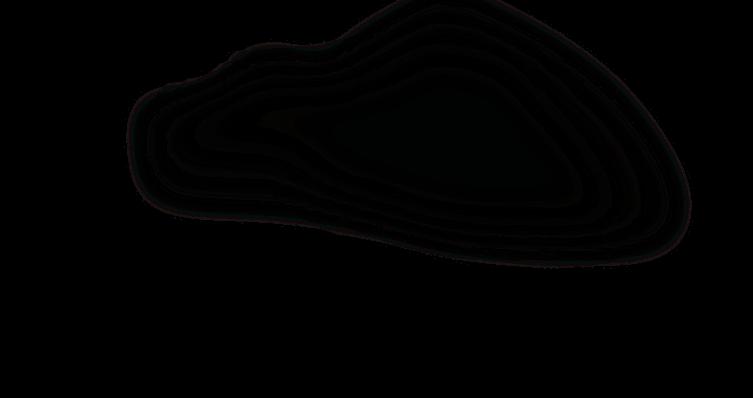
Please do not send unsolicited material, but feel free to contact the editors by email (landscope@dbca.wa.gov.au).
Published by the Department of Biodiversity, Conservation and Attractions, 17 Dick Perry Avenue, Kensington, Western Australia.
© State of Western Australia, December 2022.
Subscription information



Annual subscriptions to LANDSCOPE are available for $33* (four issues plus free postage within Australia). *Overseas subscriptions add $22. For more information contact us: On the web shop.dbca.wa.gov.au
By email landscope@dbca.wa.gov.au
By phone (08) 9219 9000
By free post Reply Paid 25, Locked Bag 29, Bentley DC, Western Australia 6983
To purchase LANDSCOPE online, visit shop.dbca.wa.gov.au/landscope
@waparkswildlife
LANDSCOPE is printed on recycled paper which contains 55 per cent recycled fibre and is made from pulp, which is derived from well-managed forests, controlled and recycled sources.
This page The stunning geology of Danggu Geikie Gorge National Park.
Photo – Janine Guenther
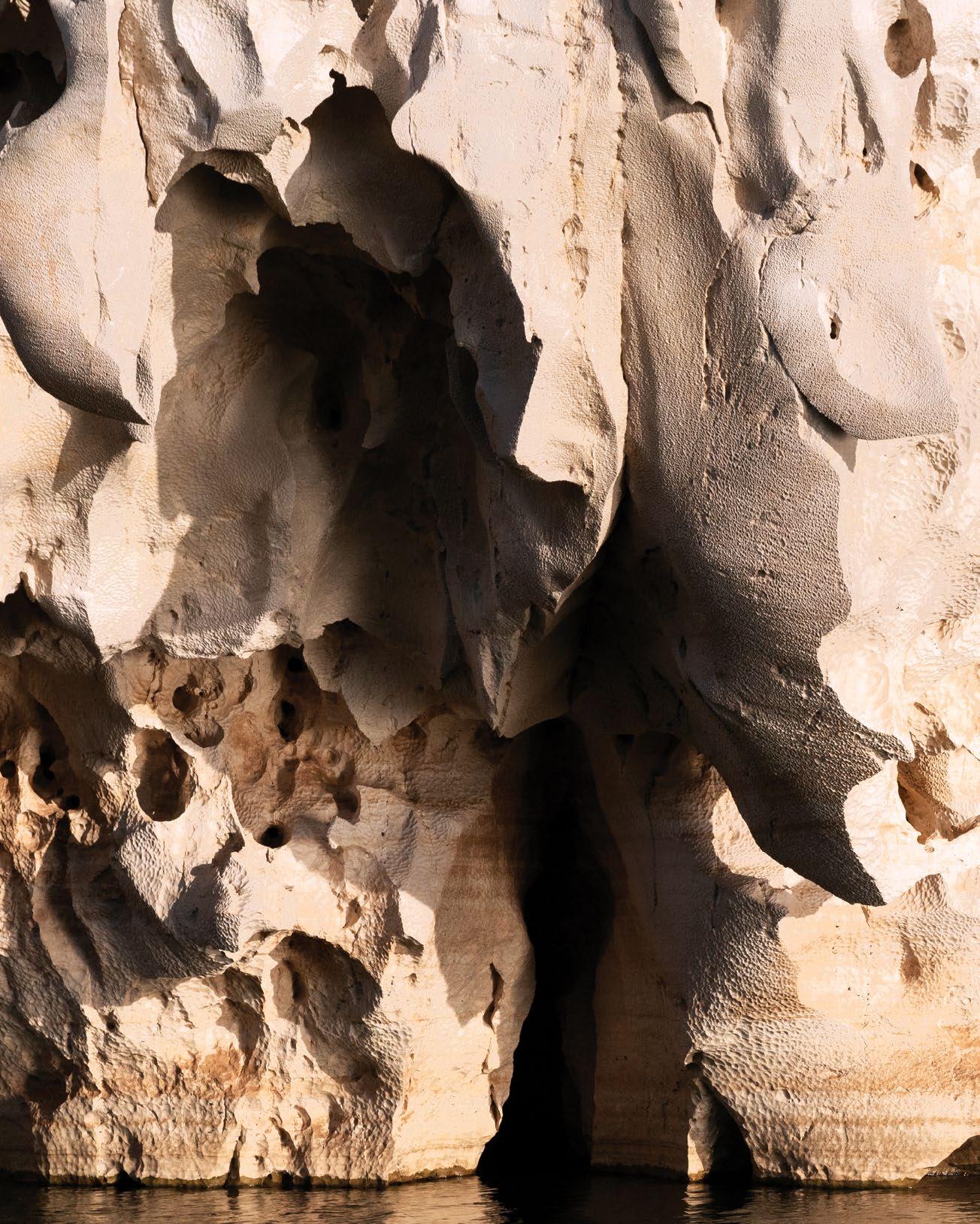
Contents Volume 38 Number 2 Summer 2022–23 4 LANDSCOPE Features 8 Parks for People: Mundy Regional Park Waterfalls and rocky outcrops in the Perth Hills 12 Connection to Country: Bunuba Nations Culture in the heart of the Kimberley 18 Safeguarding Foote’s grevillea Successful translocation of an iconic species 24 Adventure out: Yonga Walk Trail Walking in a wildflower wonderland 28 Migration mysteries Solving the puzzle of southern right whales’ migration 34 Every Kid in a Park Children of varying abilities spending time in nature 42 Seasonal knowledge of Nyinggulu coastal peoples The Baiyungu, Yiniguurdira and West Thalanyji, north-west Australia 48 Rover Task Force Improving riding and volunteering experiences on the Munda Biddi Trail Regulars 3 From
A
6 Bush telegraph Shor
11 In review A collection of books
41 Discovered Vaucheria
53 Kaleidoscope Connecting kids
54
the desk of Luke Bentley
foreword from the Manager, Aboriginal Engagement, Planning and Lands, Department of Biodiversity, Conservation and Attractions.
t stories from around the State, reader’s pic and a guest word.
and applications.
, a yellow-green seaweed.
with nature.
Nature’s pin-ups Grevillea pimeleoides

LANDSCOPE 5
READER’S PIC
Southern emu-wren (Stipiturus malachurus westernensis)
 Photo and words by Mark Davidson
Photo and words by Mark Davidson
”The southern emu-wren is one of Australia’s smallest birds, with a tail almost twice its body length. It occurs in southern coastal regions of Australia where it can be found in low heath such as peppermints. I continue to be in awe of this tiny bird that flourishes along WA’s harsh coastline. This male, distinguished by its blue bib, was one of a small group that popped up out of a peppermint beside the Bibbulmun Track east of Walpole when I was on a maintenance walk. That day was my birthday, literally and figuratively.”
Have you got a fantastic nature photograph you would like to see published in LANDSCOPE? Send it, along with a 100-word description of the species or how and where you took the shot, to landscope@dbca.wa.gov.au.
New online system for beekeeping


A new online apiary system enables beekeepers to more efficiently apply for, manage and share sites, adding value for Western Australia’s globally significant apiary industry.
The new system was developed by the Department of Biodiversity, Conservation and Attractions (DBCA) and provides approvals for apiary sites in WA’s national parks and conservation reserves, as well as on pastoral leases, mining tenements and unallocated Crown land.
To complement the online system, DBCA’s Apiary General Conditions in WA have been updated and now beekeepers must be trained on procedures to avoid the spread of Phytophthora dieback. DBCA has provided Phytophthora dieback Green Card training to beekeepers over the past year, which was positively received by the industry.
Apiculture is a significant industry in WA with a farm gate value of $50 million and it provides pollination services to the horticulture industry with a value of approximately $1.1 billion.
Guest column
Kelsie Prabawa-Sear CEO, Nature Play WA


Anature-inspired
childhood is a happier and healthier childhood, but it doesn’t end there. The latest research demonstrates how a childhood with time spent in nature builds the foundations that prepare us physically and psychologically for a happier and healthier adult life.
Some new research at University of Kent’s Durrell Institute of Conservation and Ecology explores the role of nature, smells, and human wellbeing. The research highlights the long-accepted understanding of the connection between smell and memories, and shares new learnings about the positive impact of the smells of nature on wellbeing. Perhaps most interesting to the Nature Play WA team was the revelation that smells of nature for adults brought about positive feelings most often when they were connected to childhood memories. This research shows that to be able to access these strong positive experiences as an adult, we need to have had positive experiences in nature as children.
My job is to demonstrate to adults—policy makers, healthcare professionals, educators, community leaders, parents, and all care givers—the many varied benefits of letting kids play outside and have time in nature. My approach isn’t very complicated: share the scientific research and remind them of the joy of a nature-filled childhood.
In recent years, we have seen a growing appreciation for the importance of time in nature for our kids, but as a community we haven’t been as inclusive as we could be. EVERY kid and every family benefits from time in nature and this includes kids of all abilities and backgrounds. Nature Play WA has various projects underway to try to broaden the opportunities for all kids to have positive naturebased experiences more often. We are working with kids and families from diverse communities to deliver on this. The largest project—Every Kid in a Park—and one we are so very proud of, is in partnership with DBCA.
(Amegilla sp).
Photo – Mark Berkley
You can read more about Every Kid in a Park on page 34 and how we’re supporting families of children of all abilities in accessing and enjoying the outdoors around Western Australia.
LANDSCOPE 7 Bush telegraph




































 Photo and words by Mark Davidson
Photo and words by Mark Davidson

